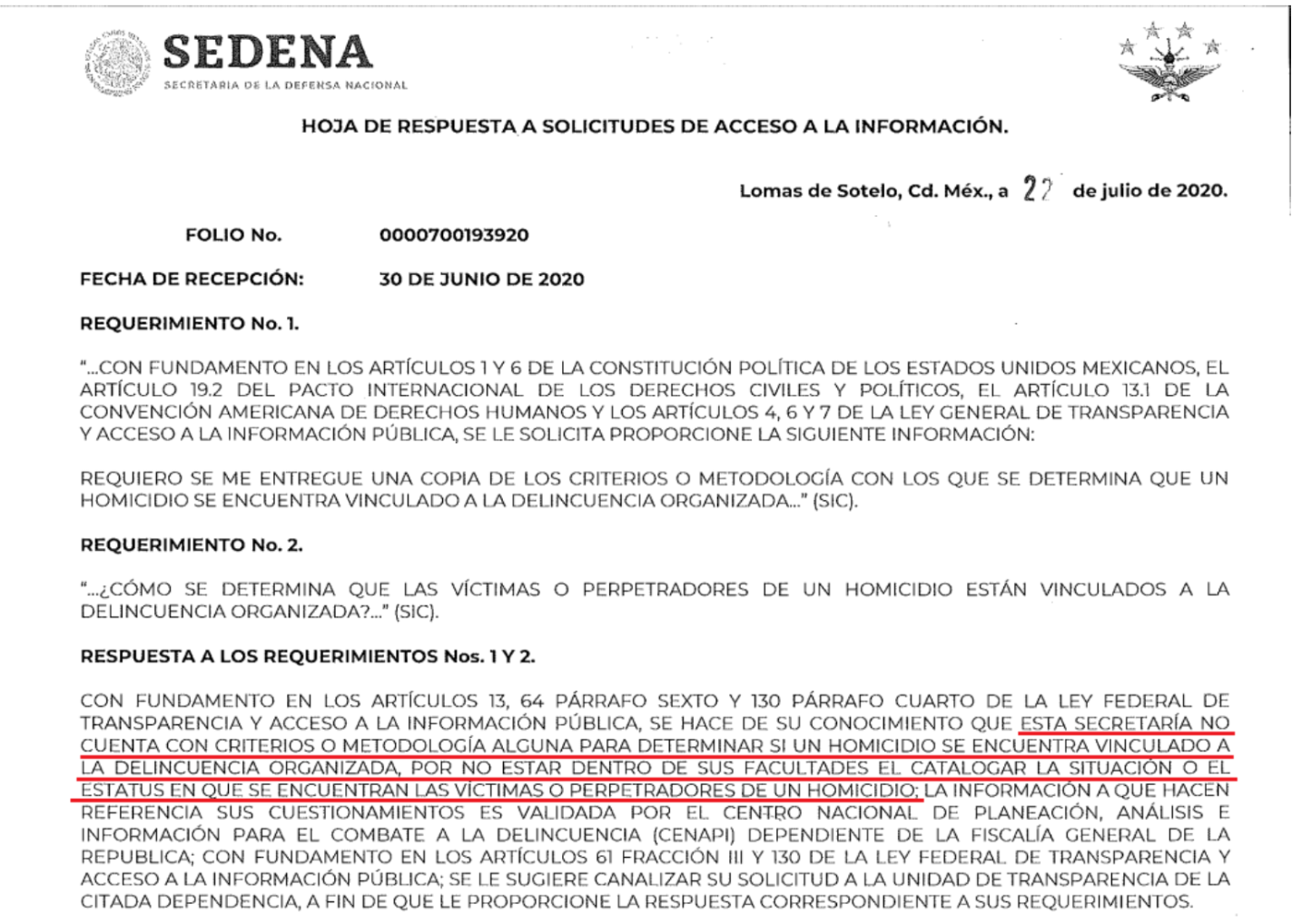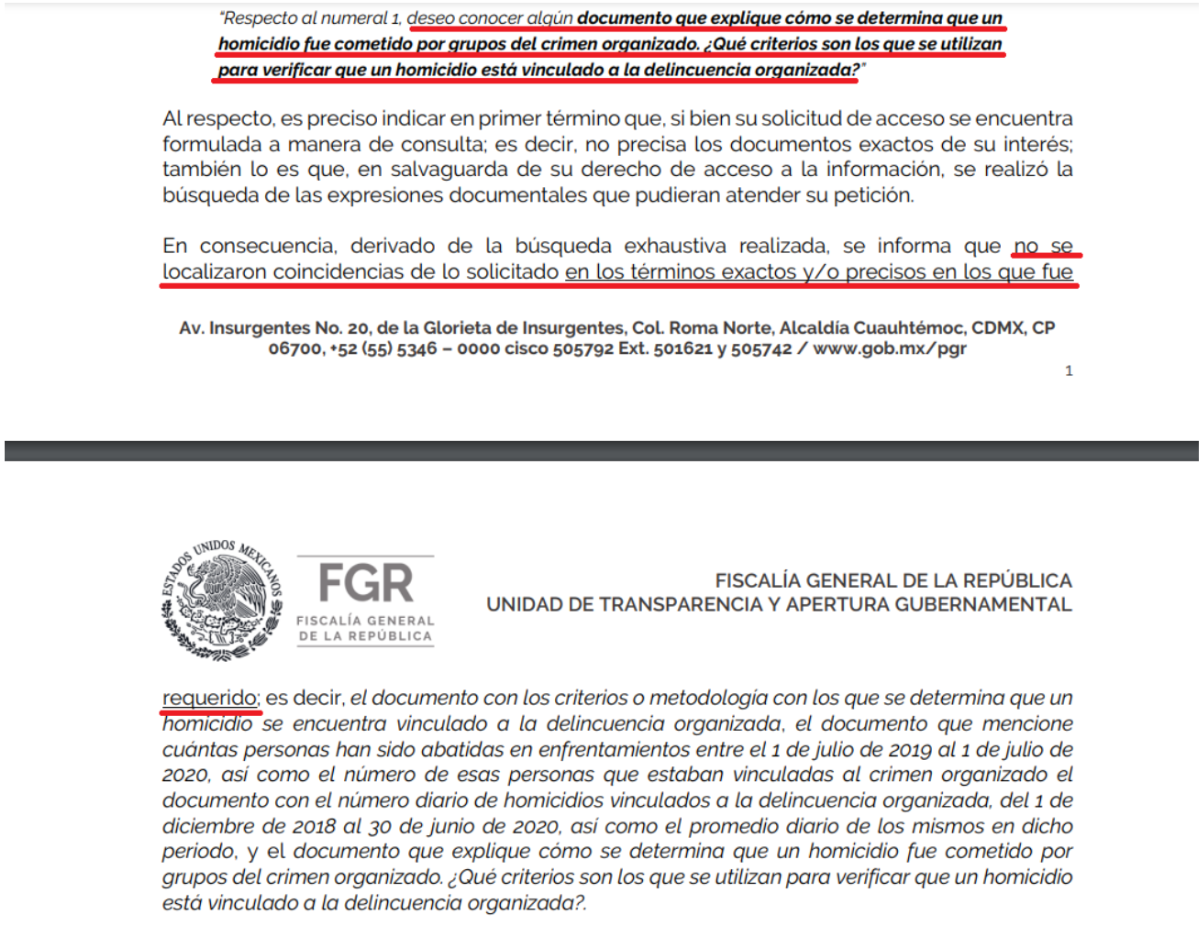Hidden Database reveals ongoing criminalization of victims in México
Feminist protest on March 8th, 2020 in Guadalajara, México. Photo: Mariana Mora.
Reportage • Mariana Mora • August 18, 2023 • Leer en castellano
Sibia Orozco was killed in her home on the night of November 3, 2020. A man entered and shot her dead in front of her family in Guadalajara, Jalisco. Her case is being investigated by state prosecutors as a potential femicide. But she's also one of the 5,529 women who appear in a government database that lists homicides supposedly linked to organized crime. In this repository, Sibia and 92.33 per cent of the women listed are cataloged as "deceased criminal suspects."
This data was contained in emails exchanged by the Secretariat of National Defense (SEDENA), which were published by the Guacamaya collective following a leak in September 2022. The leaked documents were authenticated and organized into a database by Data Cívica and Intersecta, two independent rights and research organizations in Mexico City.
The database reveals the methodology for documenting what authorities call "homicides linked to organized crime," introduced during Felipe Calderon's so-called war on drugs and maintained for at least the first two years of current president Andres Manuel Lopez Obrador's administration.
A historic leak reveals ongoing criminalization
"When we came across this database, we realized that it was very similar to the one that had previously been leaked to the CIDE [Center for Economic Research and Teaching]," said Alicia Franco, Data Cívica's data analysis coordinator.
She is referring to the database that was uploaded on to the Office of the President's website in early 2011, during the Calderón administration, before disappearing in September of the same year. This registry was created by the High Level Contact Group for the Response to Organized Crime (Grupo CANDADO), made up of SEDENA, the Ministry of the Navy (SEMAR), the Federal Ministerial Police (PFM), the now-defunct Federal Police (PF), the National Intelligence Center (CNI), the Ministry of Security and Citizen Protection (SSPC) and the National Center for Planning, Analysis and Information to Combat Crime (CENAPI).
Five years later, in 2016, CIDE received the same database via a leak, which they were able to authenticate and made public. It recorded deaths that occurred between 2006 and 2011, allegedly linked to organized crime.
For years, organizations, researchers and journalists asked government authorities for this data to be released or updated, but each time, government officials denied they had the data. Authorities were also asked about the methodology they used to establish whether a homicide was linked to organized crime. But by denying the data existed, they denied the existence of the methodology used to classify it.
This is an official response by SEDENA to an access to information request. The underlined sentence reads: “This secretariat has no criteria or methodology to determine whether a homicide is linked to organized crime, as it is not within its authority to catalog the situation or the status of the victims or perpetrators of a homicide.”
So when Franco and her colleagues found a copy of this database among the more than four million leaked SEDENA emails in 2022 they dubbed it the Hidden Database. The discovery also confirmed what was evident in the country: that the security strategy that began in 2006 was still in effect.
"Its main importance for us is the opportunity to understand how the State sees the war in Mexico," said Franco, who is trained as an economist and political scientist. For her, one of the key findings is that "a lot of violence in Mexico is justified through the criminalization of civilians."
The database logs more than 58,000 events between 2017 and 2020 that authorities linked to organized crime and in which they recorded 70,898 deaths. In 91.9 per cent of the cases it is stated that at least one of the deceased was a "criminal suspect," however, the specific criminal group the victim allegedly belonged to is only reported in 5.3 per cent of these events.
Sibia's case, coded as event 42945, is part of the 94.7 per cent of events in which there is no information about which criminal group she belonged to.
"My sister was not a criminal," Kathy Orozco, Sibia's older sister, said confidently in an interview. "It's easier to say 'who knows what she was up to' than to investigate the real cause of her femicide." Almost three years after her death, the Jalisco District Attorney has made no progress in the investigation nor has it allowed the Orozco family to review the investigation file, in violation of their legal right.
A feminist protest called the “anti-grito” on Mexico’s independence day, September 16, 2020 in Guadalajara. Photo: Mariana Mora.
The cloak of denial, shattered
Although the criminalization of victims through the Hidden Database affects men and women, the indicators that could determine whether the deceased was in fact linked in some way to organized crime, such as weapons seizures, differs. Weapons seizures were reported in 2.4 per cent of the events where only men died; in comparison, weapons seizures were reported in 0.7 per cent of the events where all the deceased were women. The data do not include gender identity, so there could be people whose assigned sex does not correspond with their identity. In addition, there are 1,099 deceased persons whose sex is not recorded.
"The stigmatizing discourse around organized crime is applied to women in the same way it has been applied to men," said Estefania Vela, who is the executive director of Intersecta and a lawyer who worked on the Hidden Database analysis.
"It serves to legitimize the lack of investigation into what happened to them, and to invisibilize the cases in which there are gender-related causes, as well as the involvement of classism or racism," said Vela via video call. Often, erroneous data are the basis for state’s justification of violence.
On March 13th of this year, president Andres Manuel Lopez Obrador stated in his daily morning press conference that 68 per cent of the homicides committed in Mexico over the previous three months were related to organized crime. "They are turf war issues," he asserted.
This narrative can be traced back to the early years of the drug war, and this administration—which in its National Development Plan vowed to "reformulate the fight against drugs" and "undertake the construction of peace"—has upheld it from the outset.
A little more than a month into his presidency, Lopez Obrador mentioned "homicides linked to organized crime" for the first time in his morning conference on January 3, 2019. He failed to disclose the criteria for defining which killings fell into this category.
A feminist protest called the “anti-grito” on Mexico’s independence day, September 16, 2020 in Guadalajara. Photo: Mariana Mora.
Meanwhile, the National Center for Planning, Analysis and Information to Combat Crime (CENAPI)—the decentralized body under the Attorney General's Office (FGR) tasked with providing crime statistics for the daily conferences and updating them weekly—also denied having this same information and thus a methodology to generate it. CENAPI repeatedly denied ro be interviewed for this story.
The formulation “homicides linked to organized crime” has been used at least 17 more times in the president's morning conferences to argue that most homicides in Mexico are the responsibility of organized crime, but also to explain "the priority is on felonies related to organized crime," as the head of SEDENA stated on September 9th of last year. "One of our hypotheses as to why we believe they keep the database is to justify the militarization strategy," said Franco of Data Cívica.
In this information access document by the Attorney General’s Office, the underlined request reads: “I request any document that explains how a homicide linked to organized crime is determined. What criteria are used to verify whether a homicide is linked to organized crime?” The FGR responds: “No exact or precise coincidences with the request were found.”
The events of the Hidden Database in which only women died are characterized, for the most part, by signs of violence on their bodies (ie. tied up by hands or feet), and murders by firearm in public or private spaces.
Article 325 of the Federal Criminal Code establishes the circumstances for determining whether the murder of a woman was gender-based. These include the presence of sexual violence, the infliction of "degrading" injuries or mutilations on the victim, or whether "the victim's body is exposed, thrown, deposited or exhibited in a public place." Many of the descriptions in the database share these characteristics; however, when these data are reported in the morning conferences, an analysis from a gender perspective is not presented.
"The government's approach is to speak of a neutral subject that is basically masculine, so the feminine is obscured and lost," said Julia Monárrez, a researcher specializing in violence against women in the context of the war in Mexico. "These terms leave both men and women outside the protections of justice, since 'they are killing each other' and these warlike confrontations are not assumed as part of what the state must prevent, sanction and eradicate."
Violence against women in the context of war
When the war began, murders of women increased sharply: in 2006, the National Institute of Geography and Statistics (INEGI) recorded an average of 3.4 violent deaths of women per day. By 2012 this average rose to 7.6 homicides per day and in 2021 it reached 10.9. In addition, in 2000, three out of ten women were killed with firearms; in contrast, in 2022, 57.97% of these homicides were committed this way.
"The women who are killed in these contexts were extremely vulnerable, so it should be analyzed from a gender perspective," said María Salguero, a geophysical engineer and creator of the Map of Femicides in Mexico. She points to conditions of marginalization, inequality and exposure to what she calls a "high criminality environment".
Salguero keeps track of all violent deaths of women since 2016, even if they are not investigated as femicide, and currently works at the Sonora Prosecutor's Office doing context analysis. Some changes she has observed in these years are the increasing use of long weapons in the murders and that some of the femicide perpetrators mimic the modus operandi of organized crime to confuse.
Meanwhile, Lopez Obrador attributes the death of these 5,529 women to the war on drugs that is still being fought in the streets. "Where there is internal drug consumption, drug dealing, there are confrontations," he assured in the same conference in which he presented the latest percentage of homicides linked to organized crime. And while this war is being fought, women continue to die violently: from January to June of this year 1,716 women were murdered; one every 2.5 hours.
A feminist protest called the “anti-grito” on Mexico’s independence day, September 16, 2020 in Guadalajara. Photo: Mariana Mora.
Resistance to militarism
Violence, criminalization and militarization in Mexico have met with fierce opposition from feminists.
This year, there were anti-militarist contingents in the March 8 mobilizations in Mexico City and Guadalajara.
"Militarization has not stopped the disappearances of people, nor the massacres throughout the country. Wouldn't it be worthwhile to think about other social solutions to stop the violence?" asked Lirba Cano, a bookseller, feminist educator and coordinator of Cuerpos Parlantes, a space for research and training where many feminists in Guadalajara have been gathering and organizing for the last ten years.
Cuerpos Parlantes convened the contingent against militarization on March 8th, and continue to build resistance to the resulting violence. "We will keep creating encounters to weave a political and affective network that helps us organize massively, when the time comes," said Cano in a phone interview with Ojalá.
These actions take on extra importance in a context in which justice seems impossible for these women who lost their lives in a war and whose death is used to continue justifying it. "For me, true justice would be to reveal the truth behind what happened to Sibia," said Kathy Orozco, who knows that in her sister's case, a lie is being upheld.







